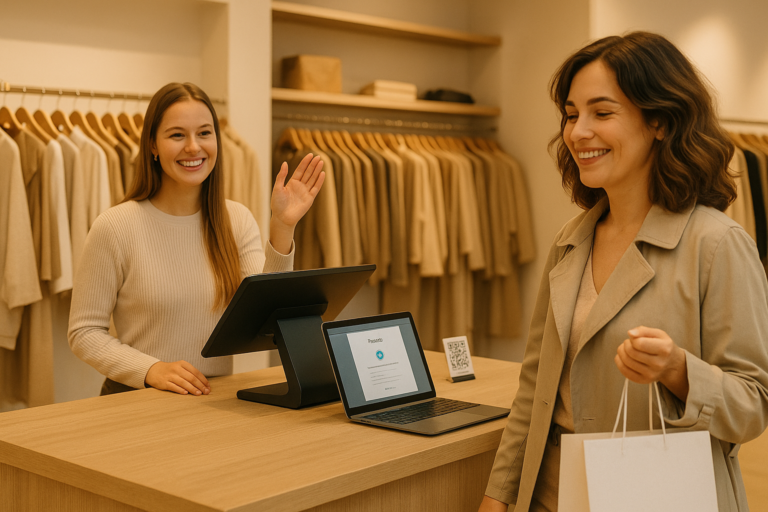The adoption of digital receipts in retail seems like a straightforward concept. Once the system and processes are installed and synched up to your in-store operations they should run like clockwork. There shouldn’t be too much input required and the data should be there ready for both retailer and customer when needed.
However, despite the ease of using digital receipts many retailers are making really critical mistakes when it comes to offering these. Some of these mistakes can be minor, simple oversights that cause friction in the purchase process or internal organisation, and others can end up preventing potential growth and not offering your customers the best possible experience.
Here we break down some of the most common mistakes retailers make, and offer solutions on how to rectify them.
1. They overlook the potential for customer engagement & retention
Receipts have traditionally been more of a customer-focused collateral. This was typically for record keeping, offering the opportunity to return and exchange, or even provide proof to someone of an item’s cost. This is still the case but now that they are digital they can be so much more powerful for both customer and retailer.
If a retailer treats their digital receipts as simply receipts they are missing out on the chance to increase that connection with their customers. From using them as a chance to nurture a post-purchase customer journey, to increasing loyalty with discounts, treating digital receipts as an extension of your marketing channels can really push them further and drive ROI from many channels.
2. They assume customers want to share email addresses
The first assumption is that customers will want to share their email addresses, the second is that they have to. There are now more privacy concerns than ever before, and data is big business. Rightfully the average shopper may not want to hand over their personal data and email information if they believe they will end up receiving multiple messages or have their data sold on. Equally important is that they often have to physically “hand over” their email address in store, either speaking it out loud to the shop assistant at the checkout counter or typing it into a tablet.
Retailers can circumvent this by using smart technology, such as that provided by refive, to offer QR codes and even NFC options to capture data. The customer can access digital receipts by using the QR code, and instead have the chance to decide if they want their email address shared, or if they want to simply download a PDF. Giving the customer the chance to choose how they want to share their data is a key component of building trust and loyalty with your brand.

3. They overlook legal and fiscal requirements
In a globalised world, where brands can cross borders and appear across continents, it is often overlooked how varied and different fiscal and privacy laws can vary. This is really key when it comes to digital receipts.
General Data Protection Regulation (GDPR), and other equivalents around the world, must be adhered to. Also tax regulations must be complied with as well. Some examples of how this can vary between two countries is comparing Germany with Norway. Germany adheres to the GDPR and requires digital receipt systems to be certified and connected to TSE to prevent data manipulation under the KassenSichV law. Meanwhile, Norway, though not an EU member, complies with GDPR via the EEA Agreement and mandates the use of government-approved cash register systems that directly report sales for accurate VAT collection. If a retailer operates in both of these countries it’s their responsibility that they make sure that their digital receipts meet both countries’ requirements. Ensuring that a company’s digital receipt system is scalable for future growth is particularly important.
4. They use the POS digital receipt (which might not integrate with other systems)
Technology is constantly evolving and developing, and what was cutting edge a few years ago may now be less innovative. This is often the case with POS systems. Decision-makers often procure these using various criteria and typically subject them to a long process of assessment and decision-making before implementation. Equally, no business wants to feel as if they are not getting a return on their investment, so while an already integrated POS system may offer digital receipts they may not be able to offer the features and functionality of a standalone or newer system.
It can be hard to argue the case to C-Level and upper management that a current system isn’t offering the functionality needed. There may be a case that it’s “fine” and does the job, and while there is an argument for implementing newer systems with more opportunities to enhance digital receipts and drive revenue, in spite of facts and stats it can be hard to make a case based on projections and forecasts.

It’s important that retailers carefully consider the alignment of their POS system, and its digital receipt capabilities, with the specific needs of their operation and overall goals. It’s only when considering things such as speed during checkout, or being able to enrich customer experience, that they can understand how they can truly optimise the experience for their customers with digital receipts.
Another thing to press towards upper management is that older systems can often result in data silos. This untapped potential means that the systems are not working hard for the business. It stifles decision-making and degrades the overall customer experience without anyone realising that there is an issue. This always impacts the bottom line, which may not manifest for years. Having a system in place that is flexible enough to adapt with future technology, ensures that the POS system (as well internal operations) can continue to be relevant.
5. They don’t test the approach before a full rollout
Retail operates in a fast-paced environment with limited time and resources for advancement. Despite this, it is crucial to pilot digital receipt solutions in a few stores and locations before a wide rollout. This may seem counterintuitive, but if a system is simple and easy to use, shouldn’t we just roll it out? But by carefully testing on a smaller control group, making adjustments as needed it can save a lot of time and issues in the future.
By doing this test run, or Proof Of Concept (POC) implementation, retailers can assess the system under a number of criteria:
- User Acceptance Evaluation: Check how both your staff and customers adapt to the system. Make sure that you are monitoring for any issues and are looking to improve the overall customer experience when using it on a small scale.
- Streamlined Transactions: Monitor to see how smoothly the checkout flow is going. By working out any bugs, or identifying any issues on a smaller scale allows you to decide whether it is a viable option without disrupting the transaction process across the whole business.
- Data Analysis for Insights: Look at and analyse the data it collects. What is useful? How does it uncover trends, analytics, behaviour and preferences? Think about how you can use this to inform your strategies.
- Goal Assessment: In this testing period assess the impact of the digital receipt in the wider picture. How can we effectively leverage and use it to achieve key objectives? This could be anything from increasing sales to increasing interaction with loyalty schemes.
- Feedback and Iteration: Listen to your customers and take action. By continually gathering this valuable feedback from users and monitoring KPIs you can smooth out the process before a larger roll out. The ideal benchmark for take up is between 10-30%, this may not happen right away but by pivoting and making tweaks you can assess whether this is feasible.

6. They accept solutions that aren’t quite right
It can be disheartening to realise when a solution isn’t working. There is often an expectation that a piece of software or process will fix all the issues that a business has. This is often not the case, but sometimes a lot of retailers, believing in the sunken cost fallacy, will accept a solution that isn’t the right fit because of the time, money and resources that have been spent into it.
Retailers should be proactive about consistently evaluating and adjusting their digital receipt strategies. This could involve regular audits and feedback sessions to help retailers stay aligned with customer expectations and operational efficiency. This ongoing vigilance not only enhances the customer experience but also safeguards the retailer’s investment in technology, ensuring that digital receipt solutions remain an asset rather than becoming a liability.
7. They write off a solution because a single test didn’t work
Equally, there is the opposite angle of this where a retailer may decide not to implement anything and believe that something like digital receipts won’t work at all because one tool or product didn’t work. This is often the case with a pilot scheme that ran into a number of hurdles along the way. Often, decision-makers choose not to pursue the initiative based on a single or a small number of solutions.
However, developers constantly evolve software and systems in line with customer feedback. It could be a case of finding an alternative solution that better fits the retailer’s requirements, or instead revisiting a solution that may not have worked with direct feedback from you as the customer.
Using Digital Receipts Effectively
Although mistakes may occur, digital receipts serve as an incredibly useful tool for retailers. The insight and ease of use facilitate quicker and easier scalability, provide customers with a more seamless experience, and offer data for making better strategic decisions.
If you have a digital receipt system but feel like it’s not working well for you, or are interested in discovering how you can prevent and overcome these issues above, reach out to refive today. Through our free demo, and expert advice, we can help retailers work out what is the best way to amplify their efforts and marketing through smart data solutions.









